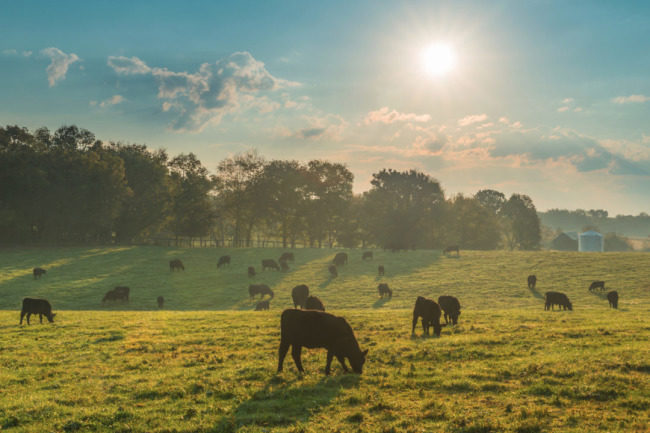It is essential that all food manufacturers think ahead in order to provide nutrition for an anticipated population of 10 billion by 2050. Some regions are experiencing increased heat and drought, while others have flooding and large, damaging storms. Agricultural lands are at risk with both scenarios, which is why industry stakeholders are doing their part to improve the ecosystem; and it all comes down to the soil.
A new documentary, “Kiss the Ground,” which is narrated by Woody Harrelson, details how regenerative agriculture has the potential to balance the earth’s climate, restore lost ecosystems and feed the world. Cows are an important part of the regenerative agriculture movement and involves managing land, cows and manure.
Regenerative agriculture is a holistic, principles-based approach to farming and ranching that seeks to strengthen ecosystem and community resilience. These practices pull carbon from the air and store it in the soil and can help the land be more resilient to extreme weather events. Additionally, regenerative agriculture practices help to increase water infiltration, improve nutrient cycling and reduce soil erosion, which have been shown to positively impact the quality of nearby lakes, rivers and streams. These benefits can translate to farmers’ pocketbooks by ensuring that more nutrients stay in the field to be absorbed by plants rather than lost to wind or water erosion. Regenerative practices on livestock farms can look slightly different than row crop farms, specifically incorporating adaptive grazing on pastures and cropland.
“Healthy soil is the cornerstone of everything we do,” said Carl Gerlach, chief executive officer of Maple Hill Creamery, Chicago. “We work tirelessly within out network of organic 100% grass-fed dairy farmers to develop and implement practices that result in the regeneration of the land through the management of organic grass-fed cows.
“When managed in harmony with nature, grazing cows are one of the most effective tools on earth as far as igniting the life in the soil, which is the foundation of the carbon cycle,” he said. “We believe that 100% grass-fed organic dairy farming done right is the pinnacle of organic and leaves the soil better than we found it.”
The same is true for beef cattle. Ruminant animals are critical to the future. Here’s why.
A stalk of corn provides two to three cobs. Humans can only digest the kernels, and for that matter, not even all the kernels. The fibrous outer shells of corn kernels pass through the gastrointestinal system undigested due to lack of the necessary digestive enzyme. The rest of that corn plant is useless to humans for energy; however, it’s a meal for ruminant animals such as cows. Cows effectively convert the nutrients in that stalk, husk and cob to meat and milk for human consumption.
A new report from The Center for Food Integrity (CFI) explains how, for the last half century, US animal agriculture has focused primarily on improving productivity, efficiency and throughput, resulting in increasing supplies of commodities that have helped assure a safe, abundant US food supply and growing export markets. The report shows a pivotal shift in cultural and market expectations for animal protein, and four emerging trends where the industry can innovate.
“American consumers have benefitted from the consistent growth in productivity and efficiency, spending less of their disposable income than consumers in any other country on food,” said Charlie Arnot, CFI CEO. “But we’ve reached an inflection point where engaged consumers, investors, policy makers and other key stakeholders have new priorities and are asking whether attributes beyond productivity and efficiency deserver greater focus.”
Four emerging innovation opportunities
The research identifies four major opportunities for the animal protein space.
- Fresh and high quality. A key opportunity is consumer desire for high-quality animal proteins, no matter the cut, because consumers view fresh, high-quality protein as healthier than low-end cuts.
- Stretching meat purchases. Consumers facing financial uncertainty are seeking ways to make meat last longer for their families, which means saving money and making fewer trips to the store.
- Ethically raised animals. Consumers continue to express concern about supporting industrial scale farms, but they don’t want to give up easy, affordable animal proteins. “Easy” means easy access and easy to prepare with a solid nutrition profile.
- Plant-based alternatives. Consumers are conflicted. They aren’t impressed with the taste of many plant-based alternatives, even when they’re looking to reduce meat consumption. They prefer the taste and texture of real animal products, but plant-based alternatives are perceived by some as “better for me and better for the planet.”
It’s time to spread the message about cows and their role in regenerative agriculture.
Consumers engaging on the topic of animal protein sit squarely in the driver’s seat as the nation continues to adapt to the evolving reality of the pandemic. Already, some innovators are actively working to meet their expectations with products that give consumers permission to enjoy animal protein, Arnot said.
“Those who follow the lead of consumers, leverage these newly identified opportunities and address the increasing array of complex challenges without sacrificing efficiency will rise to the top as the likely winners,” he said. “And those committed to preserving the status quo will be left behind


